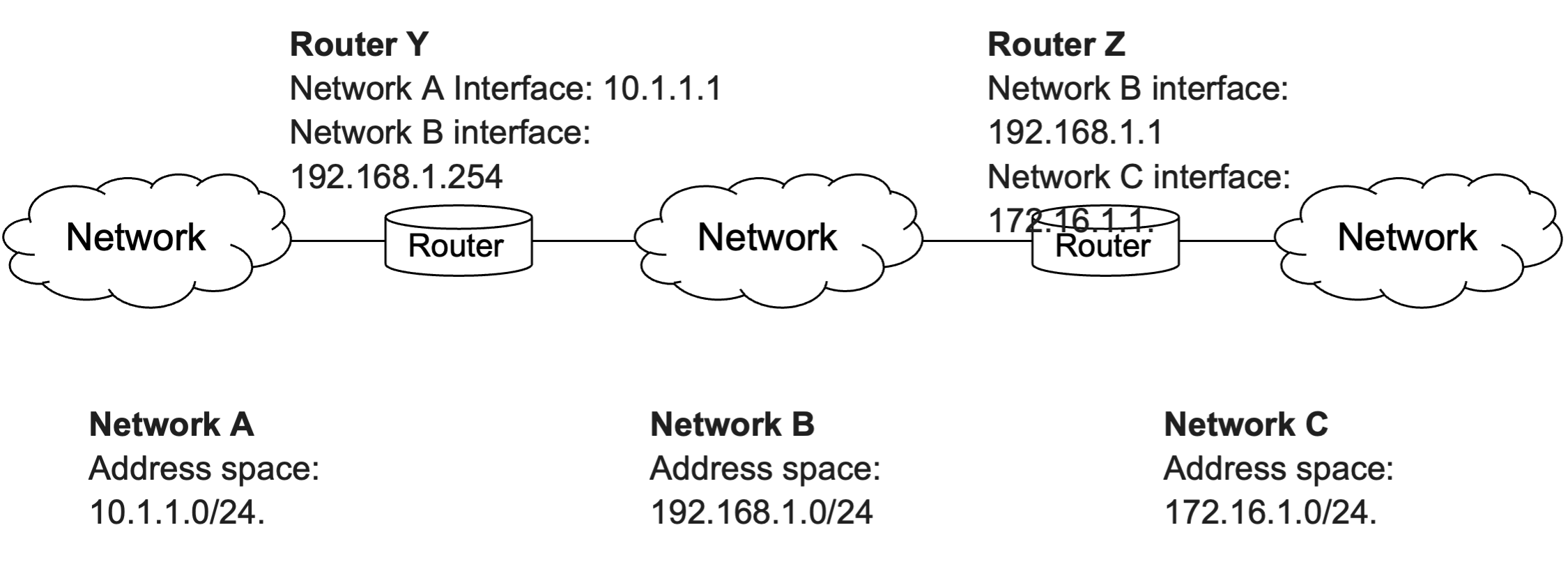Question
Use the following scenario to answer the 10 questions below: You have 3 networks (A, B, and C) and 2 routers (Y and Z). Network
Use the following scenario to answer the 10 questions below:

You have 3 networks (A, B, and C) and 2 routers (Y and Z).
Network A has an address space of 10.1.1.0/24 and is connected to router Y, using the interface 10.1.1.1.
Network B has an address space of 192.168.1.0/24 and is connected to Router Y, using the interface 192.168.1.254. Network B is also connected with router Z, using the interface of 192.168.1.1.
Network C has an address space of 172.16.1.0/24 and is connected to router Z, using the interface 172.16.1.1. The diagram below represents these connections and interfaces.
Question 1
Computer 1 on network B, with IP address of 192.168.1.233, wants to send a packet to Computer 2, with IP address of 10.1.1.205. On which network is computer 2?
1 point
a. Network C
b. Network A
c. Network B
d. Not present
2.
Question 2
What information is computer 1 looking at in the ARP table on Router Y?
1 point
a. Destination MAC address
b.MAC address
c. TTL value
d. Port number
3.
Question 3
Which layer constructs the IP datagram?
1 point
a. Application layer
b. Data layer
c. Physical Layer
d. Network layer
4.
Question 4
What information is in the data payload of the Ethernet frame?
1 point
a. IP datagram
b. network interface
c. ART message
d. Handshake
5.
Question 5
When constructing the Ethernet datagram to send the packet from Router Z to Computer 2 which is on Network C, what information needs to be in the destination MAC address?
1 point
a. Router Ys MAC address
b. Computer 1s MAC address
c. Computer 2s MAC address
d. No MAC address is needed
6.
Question 6
Computer 1 on Network A sends a packet to Computer 2 on Network C. What's the second step that Router Z does after receiving the Ethernet frame?
1 point
a. Calculates a checksum and compares this checksum with the one in the Ethernet frame header
b. Sends back the packages to router Y for confirmation
c. Sends an ARP broadcast message
d. Strips away the Ethernet frame, leaving the IP datagram. Performs a checksum calculation against the entire datagram
7.
Question 7
Computer 1 on network A, with IP address of 10.1.1.8, wants to send a packet to Computer 2, with IP address of 172.16.1.64. If the TTL value was set to 64 at the beginning, what is the value of the TTL once it reaches its destination?
1 point
a. 65
b. 62
c. 60
d. 0
8.
Question 8
Computer 1 on network A, with IP address of 10.1.1.8, wants to send a packet to Computer 2, with IP address of 10.1.1.205. Taking in consideration that computer 1 is sending a FTP request to computer 2, and the source port on computer 1 is 21086, which of the following contains the correct information for the first TCP segment of data?
1 point
a. Source Port: 21
Destination Port: 21
Sequence Number: 4
Acknowledgment Number: 1
b. Source Port: 80
Destination Port: 5000
Sequence Number: 1
Acknowledgment Number: 1
c. Source Port: 5000
Destination Port: 80
Sequence Number: 1
Acknowledgment Number: 2
d. Source Port: 21086
Destination Port: 21
Sequence Number: 1
Acknowledgment Number: 2
9.
Question 9
Computer 1 on network A, with IP address of 10.1.1.10, wants to send a packet to Computer 2, with IP address of 172.16.1.64. Which of the following has the correct IP datagram information for the fields: Version, minimum Header Length, Source IP, and Destination IP?
1 point
a. Version: 4
Header Length: 20
Source IP Address: 10.1.1.10
Destination IP address: 172.16.1.64
a. Version: 4
Header Length: 32
Source IP Address: 10.1.1.1
Destination IP address: 172.16.1.1
c. Version: 5
Header Length: 16
Source IP Address: 171.1.1.1.
Destination IP address: 172.16.1.0/24.
d. Version: 6
Header Length: 20
Source IP Address: 8a:1a:2b:3c:4d:5f
Destination IP address: 2a:2b:3c:4d:8f
10.
Question 10
The ________ layer is responsible for sending ones and zeros through a process called modulation from Computer 1 to Computer 2.
1 point
a. Physical
b. Network
c. Application
d. Transport
Step by Step Solution
There are 3 Steps involved in it
Step: 1

Get Instant Access to Expert-Tailored Solutions
See step-by-step solutions with expert insights and AI powered tools for academic success
Step: 2

Step: 3

Ace Your Homework with AI
Get the answers you need in no time with our AI-driven, step-by-step assistance
Get Started


